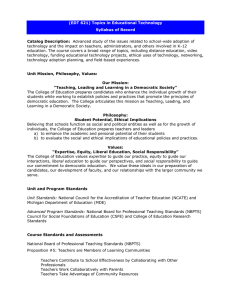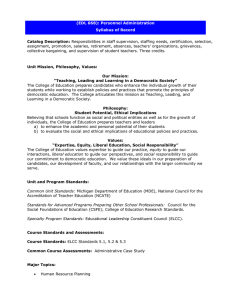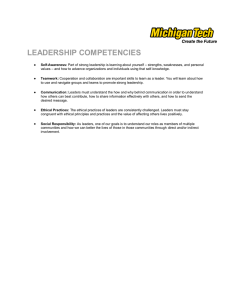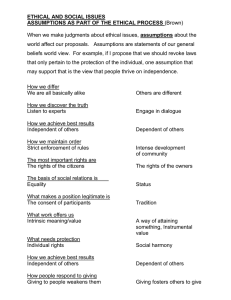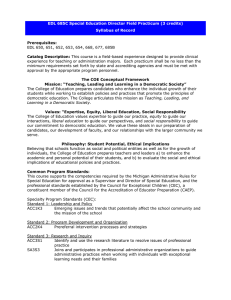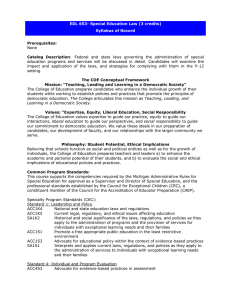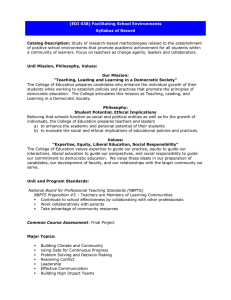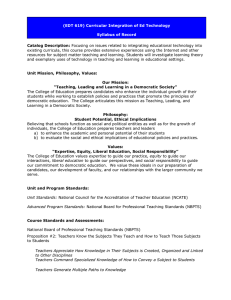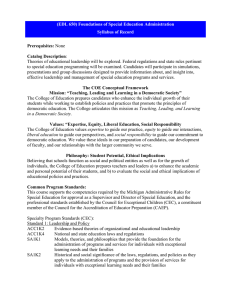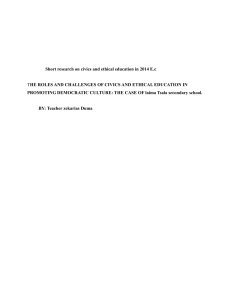forms of assessment and evaluation for student learning. This course... educational assessment, strategies for assessment of learning in technology-based Catalog Description:
advertisement
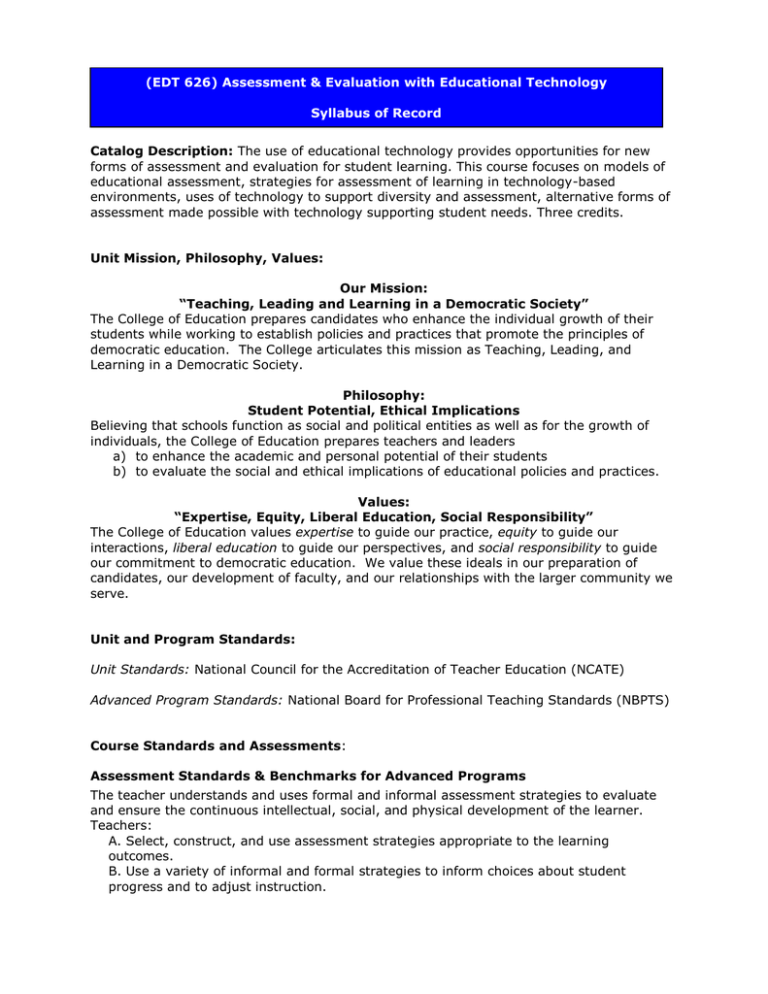
(EDT 626) Assessment & Evaluation with Educational Technology Syllabus of Record Catalog Description: The use of educational technology provides opportunities for new forms of assessment and evaluation for student learning. This course focuses on models of educational assessment, strategies for assessment of learning in technology-based environments, uses of technology to support diversity and assessment, alternative forms of assessment made possible with technology supporting student needs. Three credits. Unit Mission, Philosophy, Values: Our Mission: “Teaching, Leading and Learning in a Democratic Society” The College of Education prepares candidates who enhance the individual growth of their students while working to establish policies and practices that promote the principles of democratic education. The College articulates this mission as Teaching, Leading, and Learning in a Democratic Society. Philosophy: Student Potential, Ethical Implications Believing that schools function as social and political entities as well as for the growth of individuals, the College of Education prepares teachers and leaders a) to enhance the academic and personal potential of their students b) to evaluate the social and ethical implications of educational policies and practices. Values: “Expertise, Equity, Liberal Education, Social Responsibility” The College of Education values expertise to guide our practice, equity to guide our interactions, liberal education to guide our perspectives, and social responsibility to guide our commitment to democratic education. We value these ideals in our preparation of candidates, our development of faculty, and our relationships with the larger community we serve. Unit and Program Standards: Unit Standards: National Council for the Accreditation of Teacher Education (NCATE) Advanced Program Standards: National Board for Professional Teaching Standards (NBPTS) Course Standards and Assessments: Assessment Standards & Benchmarks for Advanced Programs The teacher understands and uses formal and informal assessment strategies to evaluate and ensure the continuous intellectual, social, and physical development of the learner. Teachers: A. Select, construct, and use assessment strategies appropriate to the learning outcomes. B. Use a variety of informal and formal strategies to inform choices about student progress and to adjust instruction. C. Use assessment strategies to involve learners in self-assessment activities to help them become aware of their strengths and needs, and to encourage them to set personal goals for learning. D. Evaluate the effect of class activities on individuals and on groups through observation of classroom interaction, questioning, and analysis of student work. E. Maintain useful records of student work and performance and can communicate student progress knowledgably and responsibly. F. Solicit information about students’ experiences, learning, behavior, needs, and progress from parents, other colleagues and students. Course Standards National Board of Professional Teaching Standards (NBPTS) Proposition #3: Teachers are responsible for managing student learning Teachers Teachers Teachers Teachers Teachers Call on Multiple Methods to Meet Their Goals Orchestrate Learning in Group Settings Place a Premium on Student Engagement Regularly Assess Student Progress Are Mindful of Their Principal Objectives Program Standards: International Society for Technology in Education (ISTE) National Educational Technology Standards for Teachers (NETS-T) IV.ASSESSMENT AND EVALUATION Teachers apply technology to facilitate a variety of effective assessment and evaluation strategies. Teachers: A. apply technology in assessing student learning of subject matter using a variety of assessment techniques. B. use technology resources to collect and analyze data, interpret results, and communicate findings to improve instructional practice and maximize student learning. C. apply multiple methods of evaluation to determine students’ appropriate use of technology resources for learning, communication, and productivity. VI. SOCIAL, ETHICAL, LEGAL, AND HUMAN ISSUES Teachers understand the social, ethical, legal, and human issues surrounding the use of technology in PK–12 schools and apply that understanding in practice. Teachers: B. apply technology resources to enable and empower learners with diverse backgrounds, characteristics, and abilities. Common course assessments: Technology assessment plan & curricular materials Major Topics: o o o o o o o o Overview of assessment & evaluation Research on assessment & evaluation Models of assessment & evaluation Technology & assessment/evaluation Case studies Planning for assessment & evaluation with technology Assistive technology Universal design for learning o Gathering & analyzing assessment data Course Knowledge Base Aleahmad, T., & Slotta, J. (2002). Integrating handheld technology and Web-based Science activities: New educational opportunities. Paper presented at the World Conference on Educational Multimedia, Hypermedia & Telecommunications, Denver, CO, June 24-29. Available online via ERIC. Beaver, R. (2004). Curriculum Design and Technology Integration. Learning and Leading with Technology, 32(1), 42-5. Available online via WilsonSelect. Boyers, J., & Nickerson, S. (2003). Linking algebraic concepts and contexts: Every picture tells a story. National Science Foundation, Arlington, VA. Available online via ERIC. Burns, A. (20006) Integrating Technology into Your Elementary Music Classroom. General music today, 20(1), 6-10. Available online via Academic Search Premier. Cradler, J. (2002/3). Effective integration. Learning and Leading with Technology, 30(4), 46-49. Available online through WilsonSelect. Doggett, M.A. (2008). The videoconferencing classroom: What do students think? Journal of Industrial Teacher Education, 44(4), 29-41. Available online via WilsonSelect Plus. Fuhrmann, S., et al. (2005). MapStats for Kids: Making Geographic Statistical Facts Available to Children. Journal of Geography (Houston), 104 (6), 233-241. Available online via WilsonSelect.
